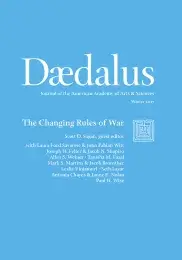The Face of Battle without the Rules of War: Lessons from Red Horse & the Battle of the Little Bighorn
This essay analyzes the extraordinary drawings of Red Horse, a Minneconjou warrior who fought at the 1876 Battle of the Little Bighorn, to provide insights into what warfare was like without just war doctrine or the laws of armed conflict to place constraints on violence. The artist’s candid vision of the battle and its aftermath portrays the indiscriminant brutality of the Great Sioux War, the disrespect given to a hated enemy, and the lingering desire for revenge. But the drawings also reveal the pride of victory and the trauma of defeat. In addition to providing a window into the past, the Red Horse drawings provide a lens to help us understand the atrocities committed by the Islamic State and Al Qaeda today and a mirror that can help us more clearly see ourselves.
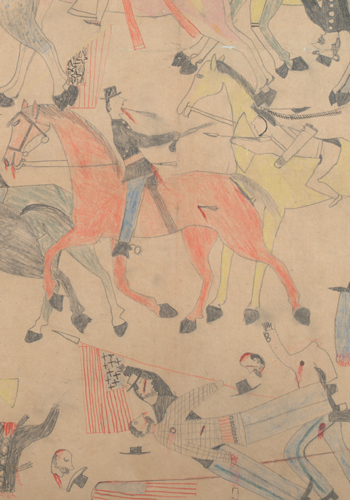
We live in a time of terror. Jailers for Islamic State (IS) routinely behead their prisoners, IS fighters force captured Yazidi women to become sex slaves, and Al Qaeda and IS terrorists have attacked the Twin Towers in New York, a sports stadium in Paris, a nightclub in Orlando, a museum and beach resort hotel in Tunisia, and many other restaurants, cafes, and markets in other countries, with the intention to kill as many innocent civilians as possible. Such acts of indiscriminant violence shock our moral sensibilities, but they should not be entirely surprising: indiscriminate violence has been commonplace in wartime throughout much of history. Indeed, flagrant and indiscriminate brutality has often been the norm. It is the modern practice of restraint in war–fighting according to ethical and legal rules that seek to spare civilians and protect prisoners–that is, from a historical perspective, highly unusual.
In The Art of War, Sun Tzu wrote that it is vitally important to “know your enemy and know yourself.” This essay uses the art of war, quite literally, to reflect on both the horrors of combat and the importance of the rules of war. The drawings of Red Horse, a Minneconjou warrior who fought against George Armstrong Custer and the Seventh Cavalry at the Battle of the Little Bighorn, enable us to see the battle through Lakota eyes. The Little Bighorn battle was part of the 1876 counterinsurgency conflict we now call the Great Sioux War. Given that the U.S. Army is once again engaged in counterinsurgency campaigns against the Taliban in Afghanistan and against the Islamic State in Syria and Iraq, it behooves us to study these extraordinary drawings carefully. For they provide both a window through which we can see more clearly the beliefs of an enemy from the past and also a mirror with which we can more clearly see ourselves today.
On March 15, 1877, newspapers across the United States reported the news that Red Horse, a Minneconjou Lakota chief, had surrendered to reservation authorities at the Cheyenne Agency. Red Horse spoke no English, but presented his recollections of the battle through Plains Sign Language, coded hand signals that Native Americans on the Great Plains had developed to communicate across tribal lines. Red Horse confirmed the public’s worst fears about the fate of the final still-missing members of George Custer’s Seventh Cavalry from the Battle of the Little Bighorn: “No Prisoners Taken” was the simple sub-headline of The New York Times that echoed across the nation.1
| Figure 1 Red Horse’s Account of the Battle of the Little Big Horn, Montana, June 25th, 1896 in Gesture-signs, to Illustrate the Syntax of the Sign-language of the N.A. Indians by Charles E. McChesney |
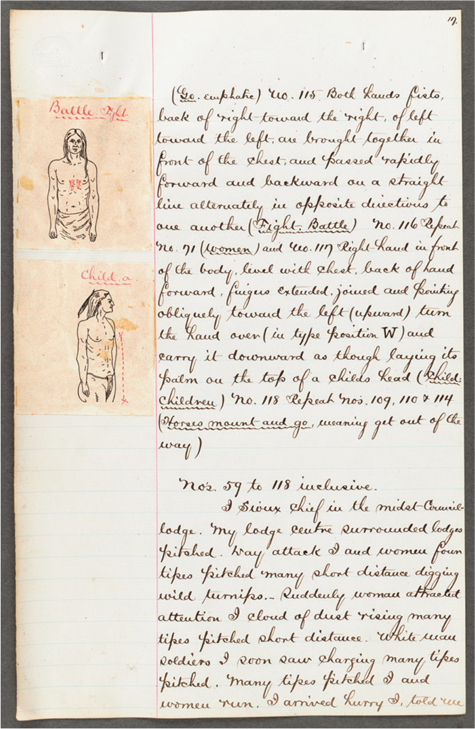 |
| Source: NAA MS 2367-b, National Anthropological Archives, Smithsonian Institution. |
Five years later, in 1881, at the request of the Agency doctor Charles McChesney, Red Horse again presented his recollections in Plains Sign Language (Figure 1).2 This time, however, Red Horse’s eyewitness testimony was supplemented by forty-two drawings depicting what he had seen on the battlefield. These drawings provided a check on the accuracy of the interpretation of Red Horse’s Plains Sign Language testimony and were commissioned primarily to help researchers understand and preserve the language. But I think it is also fair to say that the drawings are the real Red Horse testimony, more direct, more eloquent, and more moving than any translation of Plains Sign Language could be.
The forty-two Red Horse drawings are stored in the archives of the Smithsonian’s National Museum of Natural History. They are rarely displayed in the public. Indeed, they were last put on display in their entirety at the National Portrait Gallery on the centennial celebration of the battle in 1976.
Anthropologists have identified many causes of the high “visual literacy” and “recall” among Native Americans of this period: Lakota rules about recording acts of bravery, such as “counting coup” (physically touching an enemy), required having an eye witness; the Lakota being raised in a dangerous wilderness where every sound and every movement in the distance could signal danger; and in general, the lack of written language, which forced individuals to remember what they saw to better pass it on through oral history. Whatever mix of these reasons for Red Horse, we should admire his keen memory and eye for accurate and telling detail.
Red Horse was gathering turnips with women just outside the Sioux and Cheyenne village on the Little Bighorn River and had a close-up look when the forces of Custer’s second-in-command, Major Marcus Reno, attacked. The charging horses, galloping in columns of two, are bluish-gray in the front row and sorrel in the back. This color coordination was not a figment of Red Horse’s imagination. George Custer had earlier issued a controversial “coloring of the horses” order to the Seventh Cavalry, forcing soldiers to trade horses with each other so that each troop “company” rode mounts of a uniform color. This order angered the cavalrymen, who had trained their favorite horses. In issuing this order, George Custer was, like so many soldiers before and since, fighting the last war: “Coloring the horses” had provided some benefits for command and control on the mass army battlefields of the Civil War, but it served little if any strategic purpose when attacking native villages in the Great Plains. It was, however, aesthetically pleasing on the parade ground. The policy “bordered on the ornamental,” Custer acknowledged in his 1874 book, My Life on the Plains: “It was surprising to witness what a great improvement in the handsome appearance of the command was effected by this measure.”3
Red Horse must have been impressed by the color-coordinated columns of horses charging down the valley of the Little Bighorn that afternoon, for he carefully recorded the color coordination, although he would not have understood its purpose (see Figure 2). But he did notice that officers were permitted to ride their favorite horses regardless of whether they matched the others, an exception to the “coloring the horses” policy.4 Notice the soldier on the upper-right with an officer’s epaulet on his shoulder, riding a different colored horse from the rest of the attacking column.
| Figure 2 Untitled Red Horse Drawing of the Reno Attack |
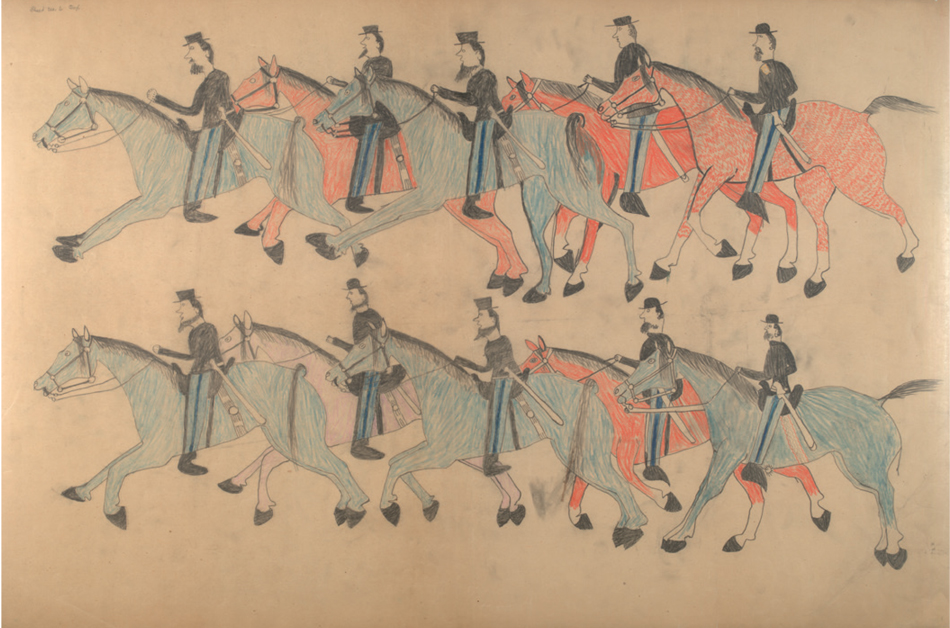 |
| Graphite, colored pencil, and ink. 61 x 92 cm. Source: The Red Horse Pictographic Account of the Battle of the Little Bighorn, 1881. NAA MS 2367A, 08568000, National Anthropological Archives, Smithsonian Institution. |
Red Horse’s drawing of the fighting on Last Stand Hill displays Native American warriors shooting bullets and arrows at the fleeing cavalrymen, and some are “counting coup” by touching a soldier, pulling him off his horse, or stabbing him with a spear (Figure 3). The color coordination of the Seventh Cavalry horses in their attack columns can still be seen, but it is starting to break down in the chaos of combat. What was also puzzling to Red Horse, according to the English translation of his 1881 Plains Sign Language testimony, was that “among the soldiers were white men who were not soldiers.” Notice the body on the lower right in Figure 3. He is wearing a plaid shirt and does not have a stripe on his trousers. This is likely a depiction of one of the three civilians killed with Custer’s troops on Last Stand Hill. Boston Custer, George’s eighteen-year-old brother, was a civilian forager with the Seventh Cavalry and Henry Armstrong “Autie” Reed, George’s teenage nephew, had come along for the ride. Their bodies were later found about one hundred yards from Custer’s. The Lakota and Cheyenne had stripped most of the cavalry uniforms off the soldiers, taken scalps, and then mutilated the bodies, including severing heads and limbs from the bodies. But they had only “slightly mutilated” Boston Custer and Autie Reed’s civilian clothing had been left on his body.5
| Figure 3 Untitled Red Horse Drawing of His View of Native Americans Fighting Custer’s Troops at the Little Bighorn, 1881 |
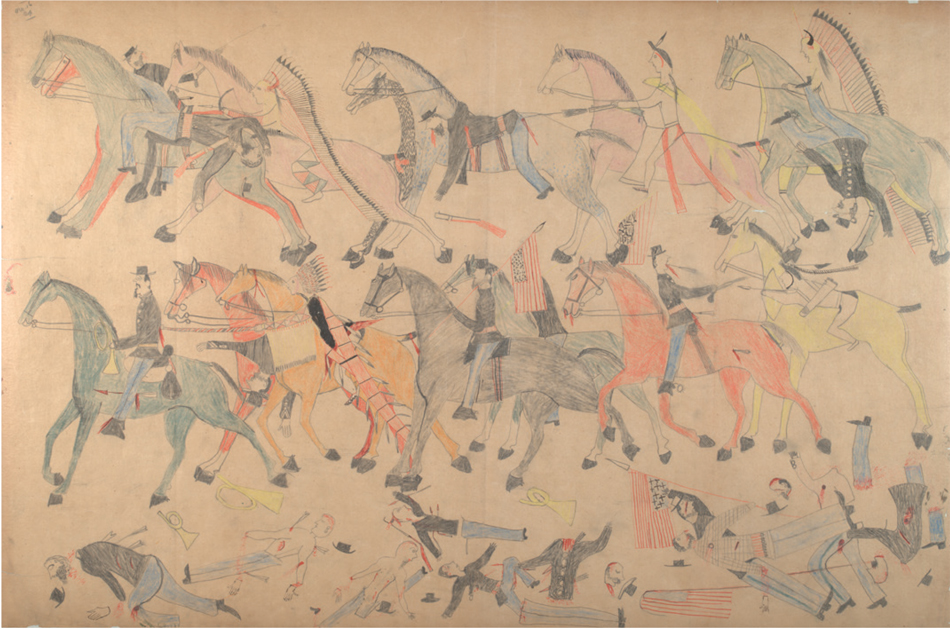 |
| Graphite, colored pencil, and ink. 61 x 92 cm. Source: The Red Horse Pictographic Account of the Battle of the Little Bighorn, 1881. NAA MS 2367A, 08569200, National Anthropological Archives, Smithsonian Institution. |
There are two exceptions to the accuracy of Red Horse’s drawings, one I can explain, the other still a mystery. The one I cannot explain is why Red Horse depicts one of the troopers carrying a saber in one of the drawings of the Reno attack on the village. All sources report that the officers of the Seventh Cavalry had left their sabers behind for the campaign, and Red Horse does not draw a single other sword in his related pictures. Perhaps one officer did carry a saber, or perhaps Red Horse was confused by the Springfield rifle scabbards, which looked like scabbards for sabers and which are clearly depicted in some of the drawings.
The other historical inaccuracy in the drawings I can explain. Notice how the flags are all inverted. Why? Keep in mind that Red Horse sees himself a POW, a prisoner of war, drawing for his captors. The inverted flags, I believe, are a coded signal of disrespect, a hidden protest, a covert act of defiance, subtle enough that white men wouldn’t notice it or perhaps would chalk it up to the primitive understanding of a savage Indian.6 Lest you think I am reading too much into this detail, note that Red Horse was not the only Native American to display an inverted U.S. flag.
This is a photo of an Osage lodge at their reservation in Oklahoma in the 1890s (Figure 4). The Osage had served as Custer’s scouts in the 1868 campaign against the Cheyenne, leading to the Battle of the Washita. They certainly knew the proper way to fly an American flag. Yet, despite their service, the Osage were removed from their traditional homes in Arkansas and Missouri and forced to move to the dry Oklahoma reservation. The photo depicts Osage men standing in quiet defiance in front of the new tribal lodge in Oklahoma.7 The tradition of displaying inverted American flags in protest and defiance was passed down from generation to generation, as seen in the 1972 photographs of the American Indian Movement’s (AIM) occupation of the Bureau of Indian Affairs headquarters in Washington, D.C. (Figure 5), and the 1973 AIM occupation of the Wounded Knee massacre site, where the Seventh Cavalry killed more than two hundred Lakota Sioux men, women, and children in 1890 (Figure 6).
| Figure 4 Osage Iloshka Lodge with Inverted American Flag, Pawhuska, Oklahoma Territory, 1890–1895 |
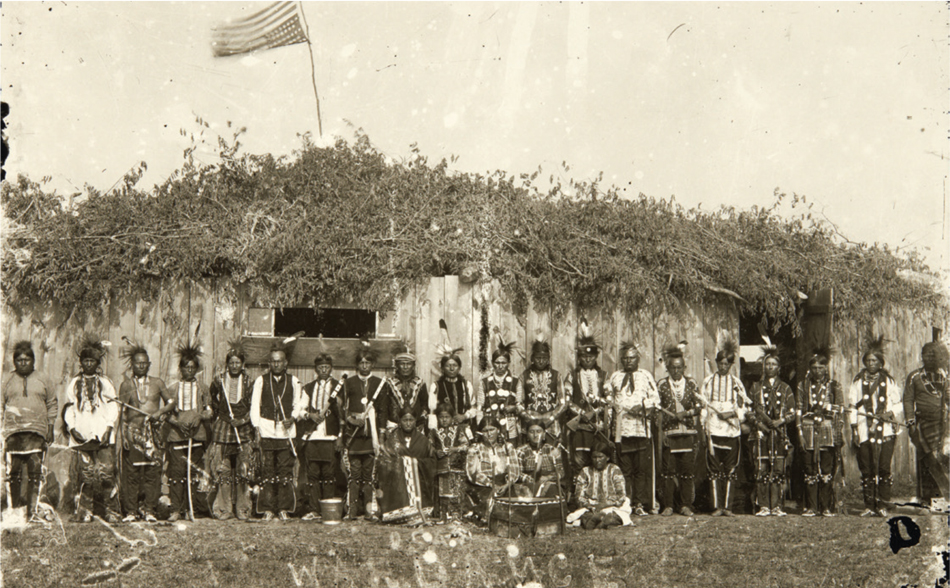 |
| George W. Parsons, photographer. Source: GM 4326.4217, Gilcrease Museum, Tulsa, Oklahoma. |
| Figure 5 American Indian Movement Occupies the Bureau of Indian Affairs, Washington D.C., 1972 |
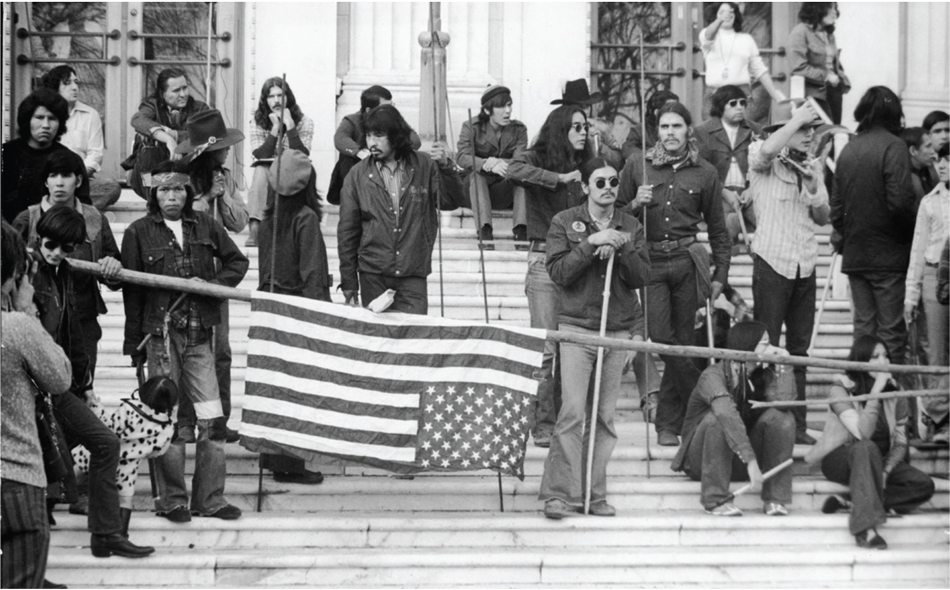 |
| Source: Pictorial Parade/Getty Images. |
| Figure 6 Inverted U.S. flag outside a Church Occupied by Members of the American Indian Movement, March 1973 |
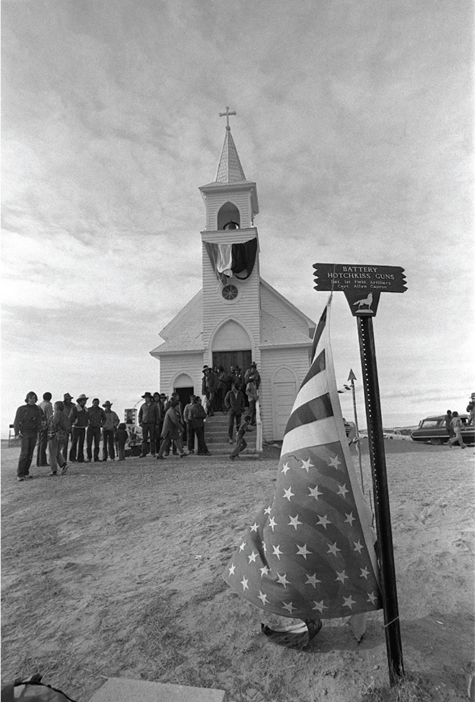 |
| Occupied church built on the site of the 1890 massacre at Wounded Knee. Source: AP Photo/Jim Mone. |
Contrast this with Red Horse’s drawing of the dead horses (Figure 7). We know that they are the Seventh Cavalry horses both because of their large size and because their tails are not tied, unlike the tails of the ponies ridden by Native American warriors. The horses are not mutilated. They are not the enemy. Red Horse has no reason to hate or disrespect them. In contrast to the inverted flags carried by the soldiers on Last Stand Hill, here, amid the horses, the Seventh Cavalry guidon is displayed properly, a sign of respect, with a red “spirit line” as a staff, showing that the Lakota now owned the flag. The once vivid colors of the bay, blue, and sorrel horses are now washed out in the sad stillness of death. The ghostly white pallor is their only color coordination. They are still displayed in parallel lines, but no longer charging across the valley in combat columns; instead the horses all look upward toward the sky, floating in a final formation of death.
| Figure 7 Untitled Red Horse Drawing of Dead Cavalry Horses, 1881 |
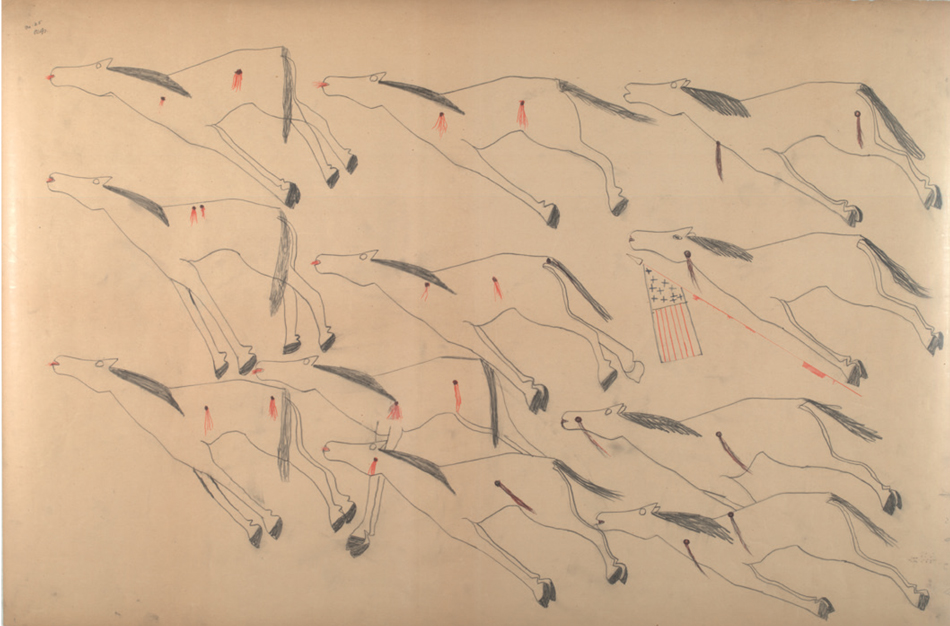 |
| Graphite, colored pencil, and ink. 61 x 92 cm. Source: The Red Horse Pictographic Account of the Battle of the Little Bighorn, 1881. NAA MS 2367A, 08569000, National Anthropological Archives, Smithsonian Institution. |
Red Horse’s striking drawings are the candid, uncensored views of a Sioux warrior. They are brutally honest and they are honest about brutality. Later ledger art about the Little Bighorn was often created for the white tourist market and was therefore self-censored.
Like this painting attributed to Stephen Standing Bear from the early 1900s (Figure 8).8 It displays no dismembered or scalped bodies and features George Custer in a buckskin jacket, with the flag flying upright in the middle of Last Stand Hill, guns blazing away, dying with his boots on.
| Figure 8 The Battle of the Little Big Horn by Standing Bear, c. 1890–1908 |
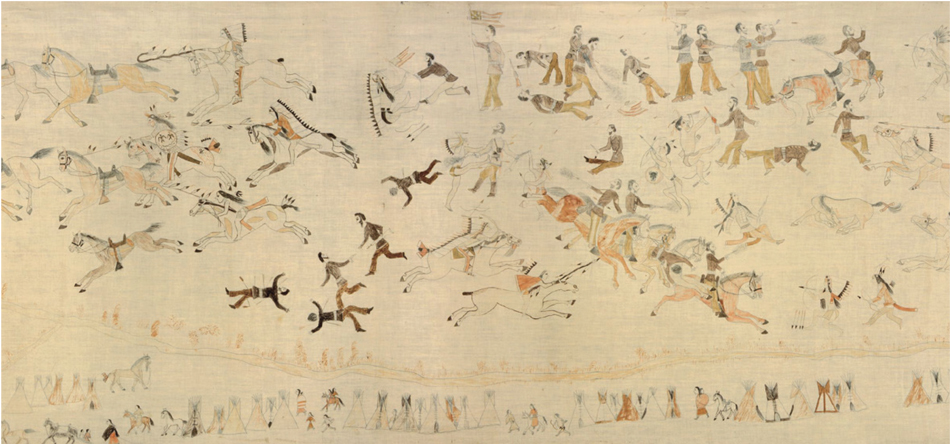 |
| Muslin, graphite, and watercolors. 42 x 156 cm. Source: Courtesy of the Karl-May-Museum, Radebeul, Germany. |
The only problems are that Custer was not wearing his buckskin jacket on that blazing hot afternoon, had cut his hair short before the campaign, and almost certainly was not the last man standing on Last Stand Hill. (Indeed, Red Horse and the other Native Americans at the Little Bighorn did not even know until afterward that it was Custer who had led the attack against their village.)
In contrast, Red Horse graphically portrays the brutality of the battle and shows no remorse about killing the enemy soldiers attacking his village, testifying in sign language in 1881 that “the women and children were in danger of being taken prisoners,” which further enraged the warriors. “These soldiers became foolish, many throwing away their guns and raising their hands and saying, ‘Sioux pity us, take us prisoners,’” Red Horse notes in his translated testimony. “The Sioux did not take a single soldier prisoner, but killed all of them.” Black Elk, a sixteen-year-old Oglala Lakota warrior, wrote later about taking a trooper’s bloody scalp back to the village and presenting it to his now proud mother who gave “a big tremolo just for me when she saw my first scalp.”9
Before the battle, Sitting Bull, the medicine man and spiritual leader of the Lakota, had told his followers of a vision that came to him in a trance during the June 1876 Sun Dance ceremony: soldiers were falling from the sky, like so many grasshoppers, upside down with their hats falling off. Sitting Bull heard a voice saying “these have no ears . . . these, they will die, but you must take none of their possessions from them.”10 The Lakota had warned the white men not to enter their territory or attack their villages, but the white men did not listen, they had no ears.
Sitting Bull’s prophecy both provided a warning that the white men would attack soon and gave the warriors confidence in their ability to defeat the Seventh Cavalry. Red Horse is here showing Lakota and Cheyenne warriors engaged in deadly hand-to-hand combat up on the ridges above the Little Bighorn (Figure 9). Dying in combat was an honor in Lakota society and Red Horse encouraged his fellow warriors to keep that in mind. According to the later testimony of Moving Robe Woman, above the “whooping and shouting” that day, she heard Red Horse shout “there is never a better time to die.”11 One important warrior wearing a long eagle-feather war bonnet is grabbing a soldier’s hair, about to take a scalp. And notice the dead soldiers falling upside down from the sky, with their hats falling off, in the upper right-hand corner.
| Figure 9 Untitled Red Horse Drawing of Lakota and Cheyenne Warriors Fighting Custer’s Horse Columns |
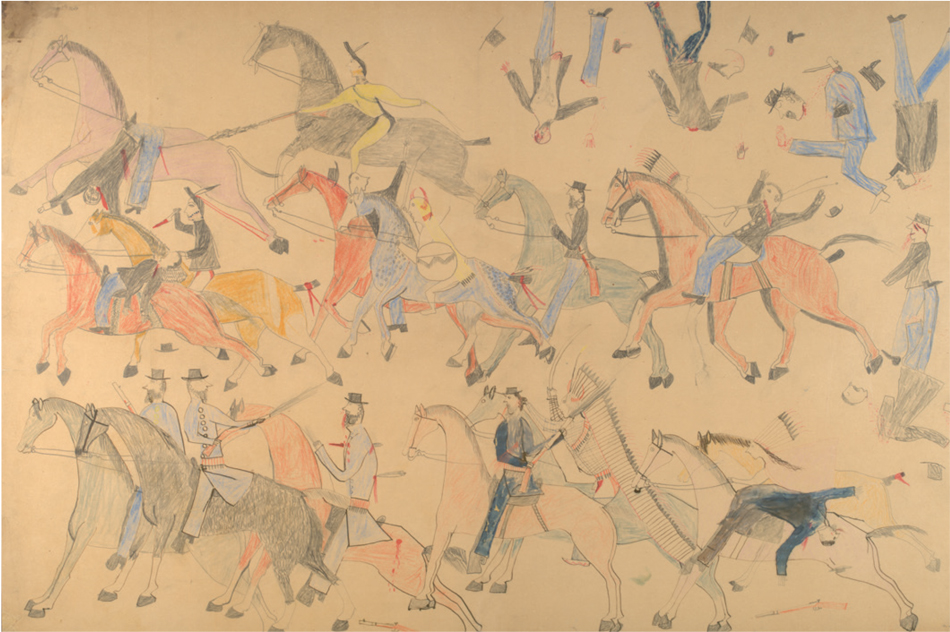 |
| Graphite, colored pencil, and ink. 61 x 92 cm. Source: The Red Horse Pictographic Account of the Battle of the Little Bighorn, 1881. NAA MS 2367A, 08583500, National Anthropological Archives, Smithsonian Institution. |
The fluid movement of the dead soldiers in this drawing leads me to believe Red Horse is recording his memory of Reno’s cavalrymen killed as they crossed the Little Bighorn in their hasty retreat, which he witnessed. It was easy killing Reno’s panicked cavalrymen. It was like hunting buffalo, another warrior, Thunder Bear, later recalled.12 The soldiers, all scalped and without arms, like fish swimming upstream, with one black campaign hat, marking each body like a gravestone, and red undulating “spirit lines” showing for the Lakota whose side the spirits were on that day on the banks of the Little Bighorn (Figure 10). Red Horse once again provides a visual reference to Sitting Bull’s vision. Note that with only a few exceptions, these dead soldiers have no ears. They didn’t listen.
| Figure 10 Untitled Red Horse Drawing of Dead Cavalry, 1881 |
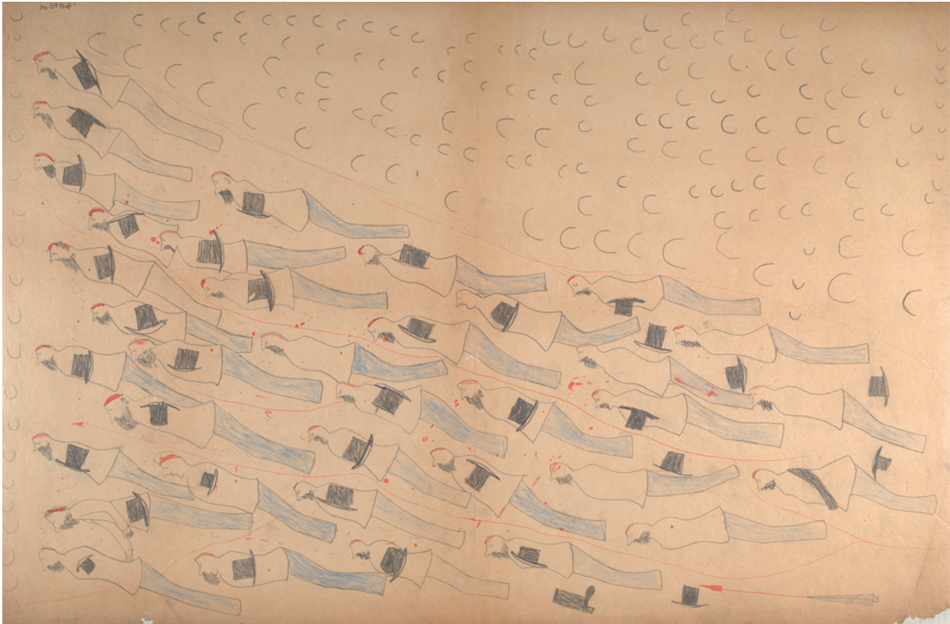 |
| Graphite, colored pencil, and ink. 61 x 92 cm. Source: The Red Horse Pictographic Account of the Battle of the Little Bighorn, 1881. NAA MS 2367A, 08570500, National Anthropological Archives, Smithsonian Institution. |
The phrase “they had no ears” has another more personal connection to the fate of George Armstrong Custer at the Little Bighorn. After the 1868 Washita campaign, Custer had smoked a ceremonial peace pipe with Cheyenne chief Medicine Arrows and had, according to Cheyenne oral history, promised not to go to war against the Cheyenne again; in response, Custer was told that he and his men would be killed if he broke his promise.13 According to Kate Bighead, a Cheyenne witness at the Little Bighorn, two Southern Cheyenne women had found Custer’s body at the top of Last Stand Hill after the fighting ceased. There they stopped two Lakota warriors who were about to take his scalp and mutilate his body, saying “ ‘he is a relative of ours,’ but telling no more about him. So the Sioux men cut off only one joint of his finger. The women then pushed the point of a sewing awl into each of his ears, into his head. This was done to improve his hearing, as it seems [he] had not heard what our chiefs in the South said when he smoked the pipe with them.”14
Kate Bighead held back the most gruesome part of the story in her oral history. For Custer and the Seventh Cavalry had killed many women and children in their 1868 attack on the Northern Cheyenne at the Washita River; and afterward, the officers sexually abused the female hostages, including Custer, who raped a young Cheyenne woman named Monahsetah.15 It appears that the Cheyenne women, when they stopped the Lakota warriors from scalping Custer, were seeking revenge and wanted to mutilate the body themselves; for George Armstrong Custer’s body was found not only with his ear drums pierced by sewing awls, but also with an arrow stuck up his penis.16
While the Red Horse drawings are candid in their portrayal of the brutality of war in 1876, there is something also profoundly human in the artist’s vision, despite the fact, or perhaps even because of the fact, that the behavior portrayed is often inhumane. Red Horse’s drawings display the common human feeling of the pride of victory. The village on the Little Bighorn quickly dispersed as bands of warriors, and their women and children, fled what he called “the walking soldiers” (General Terry’s infantry arriving from the North).
Look at their proud display of colorful shields and bonnets–the heraldry of a victory parade (Figure 11). The warriors would soon be marking their shirts with symbols of each coup counted, symbols of honor and accomplishment not unlike the medals officers wear today. And look at the bounty they took away: the larger U.S. Army horses amid the smaller Indian ponies, the saddles, and the new guns (contrasted with warriors armed with only some guns amid many spears, clubs, and bows and arrows in the earlier pictures). They have made the rifles their own, decorating the gunstocks with swirls of colorful paint. Most of the soldiers’ cavalry hats remain scattered among the dead. But one warrior rides off (upper left), proudly wearing a white man’s hat to shield his eyes from the glare of the sun.
| Figure 11 Untitled Red Horse Drawing of Native American Warriors Leaving the Battle of the Little Bighorn, 1881 |
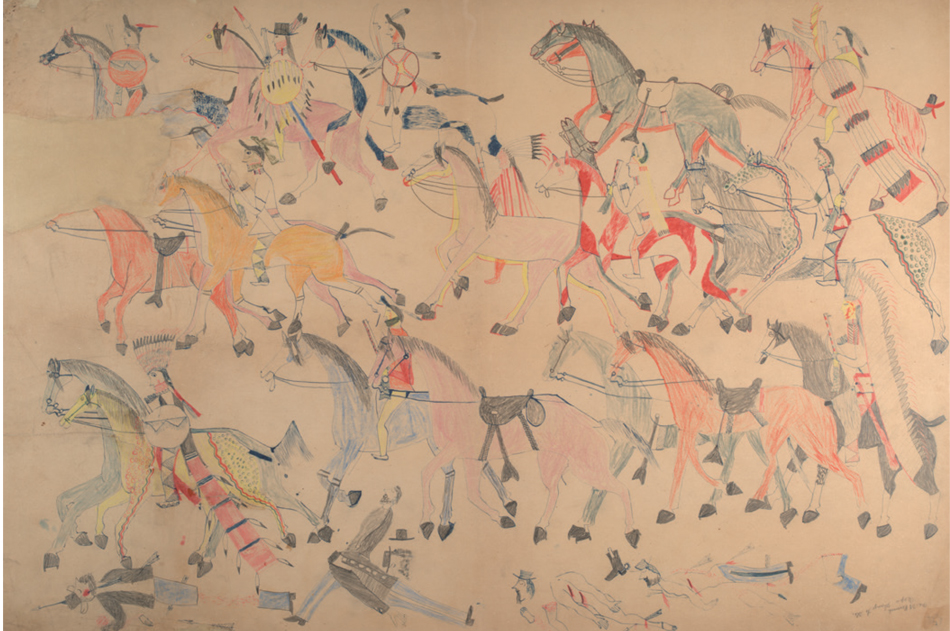 |
| Graphite, colored pencil, and ink. 61 x 92 cm. Source: The Red Horse Pictographic Account of the Battle of the Little Bighorn, 1881. NAA MS 2367A, 08570700, National Anthropological Archives, Smithsonian Institution. |
These portraits serve as a haunting reminder of the tremendous human suffering after war, among both the victors and the vanquished. While Red Horse’s drawings do not display remorse over killing the white soldiers who had attacked his village, his final words in the 1877 Plains Sign Language testimony do hint at a kind of unspoken sadness, perhaps even trauma, not unlike the experience of many American warriors today when looking back at their combat experience. “I don’t like to talk about that fight,” Red Horse said. “If I hear any of my people talking about it I always move away.”
The Red Horse drawings present the face of battle without the rules of war. His graphic depictions of the mutilated bodies of the U.S. Army soldiers show the horrific consequences of our all-too-human feelings of revenge and hatred. In an era in which the Islamic State beheads its enemies and mistreats its prisoners, it is important to keep in mind that mistreatment of prisoners and mutilation and the taking of body parts was once common practice.
In the aftermath of King Phillip’s War, New England puritans placed the heads of Native Americans on the walls of their stockades.17 The First and Third Colorado regiments of United States Volunteers killed over two hundred Cheyenne men, women, and children in the November 1864 Sand Creek Massacre, taking body parts and scalps and waving them for cheering crowds in their victory parade back into Denver.18 According to Seventh Cavalry officer Sergeant John Ryan, to inspire his men at the start of Reno’s charge on the Little Bighorn, Lieutenant Charles Varnum shouted out “Thirty days furlough to the man who gets the first scalp.”19 Lieutenant W. S. Edgerly also later testified under oath at Reno’s trial that he saw a Seventh Cavalry soldier at the battle carrying “the scalp of an Indian in his hand that he had just taken.”20 And Buffalo Bill Cody famously killed and scalped the young Cheyenne warrior, Yellow Hair, in a battle in July 1876 to avenge for the killings at the Little Bighorn; he reenacted his “first scalp for Custer” story during his Wild West Show for years afterward.21
The practice of scalping or taking body parts of an enemy as a visceral token of victory was recorded as early as Herodotus, and is occasionally witnessed today, even in the U.S. Army. For example, the ringleader of the Maywand “Kill Team,” a group of U.S. soldiers stationed near Kandahar who murdered Afghan civilians for sport in 2010, carried home body parts of his victims, including fingers and a tooth, as trophies.22 We should be ashamed that this incident occurred, but gratified that eleven American soldiers were put on trial by the U.S. military, and that the Maywand “Kill Team” leader, Staff Sergeant Calvin Gibbs, was convicted of murder and is spending his life in a military prison for the war crimes he committed.
General George C. Marshall, on his first assignment fresh out of the Virginia Military Institute, told a fellow officer: “Once an army is involved in war, there is a beast in every fighting man which begins tugging at its chains. And a good officer must learn early on how to keep the beast under control, both in his men and himself.”23
The Geneva Conventions and the laws of armed conflict are major achievements, a triumph of international institutions and a rare victory for the better angels of our nature. The Red Horse drawings portray what combat is like without the effects of just war doctrine and laws of war. They should remind us of the continual need to “stay the hand of vengeance” in war, as Justice Robert H. Jackson put it at the Nuremburg Trials. It is necessary to fight effectively, but also to fight well, both to defeat the beast in our enemies and control the beast within ourselves.
ENDNOTES
1“The Custer Massacre: An Indian Chief’s Account of It,” The New York Times, March 15, 1877.
2For more on Red Horse and his sign language accounts of the battle, see Sarah A. Sadlier, “In Search of Red Horse: Interpreting the Lost Life and Times of a Minneconjou Lakota Artist and Warrior” (undergraduate thesis, American Studies Honors Program, Stanford University, 2016).
3George A. Custer, My Life on the Plains (New York: Sheldon and Company, 1874), 141–142.
4Gary Paul Johnston, James A. Fischer, and Harold A. Geer, Custer’s Horses (Prescott, Ariz.: Wolfe Publishing, 2000), 81.
5The other civilian killed on the battlefield was the Bismark Tribune reporter Mark Kellogg, but his body was found in the Deep Ravine, not on top of Last Stand Hill. Richard G. Hardoff, The Custer Battle Casualties (El Segundo, Calif.: Upton and Sons, 1991), 121–122.
6For more examples, see Michael H. Logan and Douglas A. Schmittou, “Inverted Flags in Plains Indian Art: A Hidden Transcript,” Plains Anthropologist 52 (202) (2007): 209–227.
7On the Osage use of inverted flags to display displeasure, see Douglas A. Schmittou and Michael H. Logan, “Fluidity of Meaning: Flag Imagery in Plains Indian Art,” American Indian Quarterly 26 (4) (Fall 2002): 585–587.
8See Rodney G. Thomas, Rubbing Out Long Hair (Pehin Hanska Kasota): The American Indian Story of the Little Big Horn in Art (Spanaway, Wash.: Elk Plain Press, 2009), 197.
9John G. Nieinhardt, Black Elk Speaks (Lincoln: University of Nebraska Press, 2014), 70.
10Raymond J. DeMallie, “ ‘These Have No Ears’: Narrative and the Ethnohistorical Method,” Ethnohistory 40 (4) (Autumn 1993): 519.
11Richard G. Hardroff, ed., Lakota Recollections of the Custer Fight: New Sources of Indian-Military History
(Lincoln: University of Nebraska Press, 1991), 95.
12Richard G. Hardorff, Indian Views of the Custer Fight: A Source Book (Norman: University of Oklahoma Press, 2005), 88.
13John Stands in Timber and Margot Liberty, Cheyenne Memories, 2nd ed. (New Haven, Conn.: Yale University Press, 1998), 82. For Custer’s own account of the pipe-smoking ceremony, see Custer, My Life on the Plains, 240–241.
14Thomas B. Marquis, She Watched Custer’s Last Battle (Scottsdale, Ariz.: Cactus Pony, 1933), 8.
15The best source on Monasetah is Peter Harrison (with Gary Leonard, ed.), Monasetah: The Life of a Custer Captive (Southampton, United Kingdom: Chetwynd Press, 2015). See also T. J. Stiles, Custer’s Trials: A Life on the Frontier of a New America (New York: Knopf, 2015), 327; and Louise Barnett, Touched by Fire: The Life, Death, and Mythic Afterlife of George Armstrong Custer (Lincoln: University of Nebraska Press, 2006), 194–197.
16Hardoff, The Custer Battle Casualties, 21.
17Jill Lapore, The Name of War: King Phillip’s War and the Origins of American Identity (New York: Knopf, 1998), 178.
18Ari Kelman, A Misplaced Massacre: Struggling over the Memory of Sand Creek (Cambridge, Mass.: Harvard University Press, 2013), 1–43.
19John M. Ryan, “John M. Ryan’s Story of the Battle,” Hardin Tribune, June 22, 1923, http://www.astonisher.com/archives/museum/john_ryan_little_big_horn.html.
20Robert M. Utley, The Reno Court Inquiry: The Chicago Times Account (Fort Collins, Colo.: The Old Army Press, 1972), 341.
21Paul L. Hedren, “The Contradictory Legacies of Buffalo Bill’s First Scalp for Custer,” Montana: The Magazine of Western History 55 (1) (Spring 2005): 16–35.
22William Yardley, “Soldiers Convicted of Killing Afghan Civilians for Sport,” The New York Times, November 10, 2011.
23See Luke Mogelson, “A Beast in the Heart of Every Fighting Man,” The New York Times Magazine,
April 27, 2011, http://www.nytimes.com/2011/05/01/magazine/mag-01KillTeam-t.html?_r=0.
